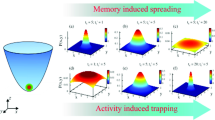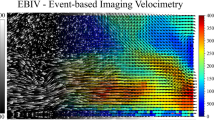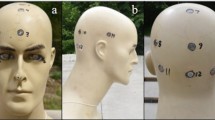Abstract
We present results of an experimental study of blast wave propagation and particle dispersion induced by a free-field detonation of spherical charges made of a 125 g C-4 explosive surrounded by inert or reactive particles. Visualization of the flow was performed with a high-frame-rate video camera. Background oriented Schlieren (BOS) methods were adapted to process the images that allowed the detection of the shock waves. BOS analysis also revealed that particles form agglomerates, which may generate precursor perturbations on the recorded pressure signals. While inert glass particles notably delay the shock, the combustion of aluminium particles can accelerate it, especially if they are small atomized or flaked particles. When a mixture of inert glass particles with reactive particles is dispersed, the agglomerates are formed by coalescence of both materials.














Similar content being viewed by others
References
Frost, D.L., Ornthanalai, C., Zarei Z., Tanguay, V., Zhang, F.: Particle momentum effects from the detonation of heterogeneous explosives. J. Appl. Phys. 101(11), 113529 (2007)
Zhang, F. (ed.): Shock wave science and technology reference library. In: Heterogeneous Detonation, vol. 4, pp. 87–168. Springer, Berlin (2009)
Brousseau, P., Dorsett, H.E., Cliff, M.D., Anderson, C.J.: Detonation properties of explosives containing nanometric aluminium powder. In: 12th Detonation Symposium. San Diego, California (2002)
Kinney, G.F., Graham, K.J.: Explosive Shocks in Air. Springer, Berlin (1962)
Meier, G.E.A.: Computerized background-oriented Schlieren. Exp. Fluids. 33, 181–187 (2002)
Gladstone and Dale: Researches on refraction, dispersion and sensitiveness of liquids. Phil. Trans. 153, 317–343 (1863)
Taylor, G.I.: The instability of liquid surfaces when accelerated in a direction perpendicular to their planes. Proc. R. Soc. A 201, 192–196 (1950)
Richtmyer, R.D.: Taylor instability in shock acceleration of compressible fluids. Commun. Pure Appl. Math. 13, 297–319 (1960)
Meshkov, E.E.: Instability of a shock wave accelerated interface between two gases. Soviet Fluid Dyn. 4, 107–108 (1969)
Milne, A.M., Parrish, C., Worland, I.: Dynamic fragmentation of blast mitigants. Shock Waves 20(1), 41–51 (2010)
Author information
Authors and Affiliations
Corresponding author
Additional information
Communicated by H. Kleine.
Rights and permissions
About this article
Cite this article
Grégoire, Y., Sturtzer, MO., Khasainov, B.A. et al. Cinematographic investigations of the explosively driven dispersion and ignition of solid particles. Shock Waves 24, 393–402 (2014). https://doi.org/10.1007/s00193-014-0500-0
Received:
Revised:
Accepted:
Published:
Issue Date:
DOI: https://doi.org/10.1007/s00193-014-0500-0




